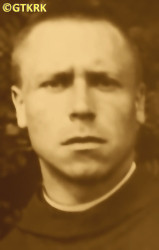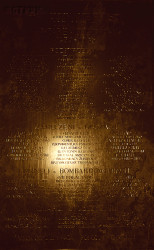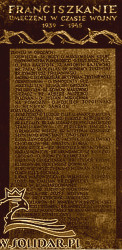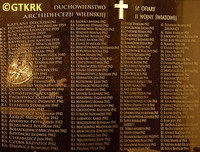Roman Catholic
St Sigismund parish
05-507 Słomczyn
85 Wiślana Str.
Konstancin deanery
Warsaw archdiocese, Poland
full list:
displayClick to display full list

searchClick to search full list by categories
wyświetlKliknij by wyświetlić pełną listę po polsku

szukajKliknij by przeszukać listę wg kategorii po polsku

Martyrology of the clergy — Poland
XX century (1914 – 1989)
personal data
surname
SOBOLEWSKI
forename(s)
Steven (pl. Stefan)
religious forename(s)
Pacific Mary (pl. Pacyfik Maria)
function
religious cleric
creed
Latin (Roman Catholic) Church RCmore on
en.wikipedia.org
[access: 2014.09.21]
congregation
Order of Friars Minor Conventual OFMConvmore on
en.wikipedia.org
[access: 2013.05.19]
(i.e. Conventual Franciscans)
diocese / province
Immaculate Mary province OFMConvmore on
pl.wikipedia.org
[access: 2014.08.18]
st Anthony of Padua and bl. James Strzemię province OFMConvmore on
pl.wikipedia.org
[access: 2014.08.18]
date and place
of death
12.10.1939

Induratoday: Indura ssov., Grodno dist., Grodno reg., Belarus
more on
en.wikipedia.org
[access: 2022.01.06]
alt. dates and places
of death
12.10.1942, 17.10.1942
Ruda Yavorskayatoday: Khvinevichi ssov., Dzyatlava dist., Grodno reg., Belarus
more on
be.wikipedia.org
[access: 2022.10.26]
details of death
After German and Russian invasion of Poland in 09.1939 and start of the World War II, after start of Russian occupation, during murderous attacks of Commie‐Nazi Belarusian bands on Polish population (Belarusians axed to death the local Zaczepice commune's mayor, attacked the rectory, among others), after a Holy Mass in a nearby Turejsk village on Niemen river decided to go to Suwałki, to his family.
On the way apprehended by the Belarusians, had his britzka — horse–drawn carriage — and horse stolen, was beaten up and brought to Indura town (roughly half way to Suwałki).
There locked up in a basement of magistrate building.
Tortured by the local Belarusians collaborating with Russian occupiers — had his head smashed.
Finally after few days murdered.
The body was dumped into a well.
cause of death
murder
perpetrators
Belarusians / Russians
sites and events
Ribbentrop‐MolotovClick to display the description, Pius XI's encyclicalsClick to display the description
date and place
of birth
11.09.1911

Bocianowotoday: part of Zielone Drugie village, Suwałki gm., Suwałki pov., Podlaskie voiv., Poland
more on
en.wikipedia.org
[access: 2022.02.14]
alt. dates and places
of birth
11.08.1911
parents
SOBOLEWSKI Alexander
🞲 ?, ? — 🕆 ?, ?

MICHAŁOWSKA Julianna
🞲 ?, ? — 🕆 ?, ?
religious vows
01.11.1931 (temporary)
1934 (permanent)
presbyter (holy orders)
ordination
23.06.1935

Krakówtoday: Kraków city pov., Lesser Poland voiv., Poland
more on
en.wikipedia.org
[access: 2021.06.07]
positions held
1938 – 1939
vicar — Ruda Yavorskayatoday: Khvinevichi ssov., Dzyatlava dist., Grodno reg., Belarus
more on
be.wikipedia.org
[access: 2022.10.26] ⋄ Immaculate Conception of the Blessed Virgin Mary RC church ⋄ Dzyatlavatoday: Dzyatlava dist., Grodno reg., Belarus
more on
en.wikipedia.org
[access: 2022.01.06], Assumption of the Blessed Virgin Mary RC parish ⋄ Dzyatlavatoday: Dzyatlava dist., Grodno reg., Belarus
more on
en.wikipedia.org
[access: 2022.01.06] RC deanery
1938 – 1939
friar — Zachepichitoday: Orlya ssov., Shchuchyn dist., Grodno reg., Belarus
more on
be.wikipedia.org
[access: 2022.10.26] ⋄ St Peter and St Paul the Apostles monastery, Conventual Franciscans OFMConv — prefect of primary schools
1938
friar — Grodnotoday: Grodno dist., Grodno reg., Belarus
more on
en.wikipedia.org
[access: 2023.01.18] ⋄ Blessed Virgin Mary of the Angels monastery, Conventual Franciscans OFMConv
1936 – 1938
friar — Niepokalanówtoday: part of Paprotnia village, Teresin gm., Sochaczew pov., Masovia voiv., Poland
more on
en.wikipedia.org
[access: 2021.10.09] ⋄ Immaculate Conception of the Blessed Virgin Mary monastery, Conventual Franciscans OFMConv — head of monastic studies and library (1937‐1938), senior sacristan (1937) and retreatist
1935 – 1936
friar — Krakówtoday: Kraków city pov., Lesser Poland voiv., Poland
more on
en.wikipedia.org
[access: 2021.06.07] ⋄ St Francis of Assisi monastery, Conventual Franciscans OFMConv
1931 – 1935
student — Krakówtoday: Kraków city pov., Lesser Poland voiv., Poland
more on
en.wikipedia.org
[access: 2021.06.07] ⋄ Philosophical and Theological Studies, St Francis of Assisi monastery, Conventual Franciscans OFMConv
31.10.1930 – 01.11.1931
novitiate — Conventual Franciscans OFMConv
1930
accession — Conventual Franciscans OFMConv
author of articles published in „Niepokalanów Echo” and „Knighthood of the Immaculata Informant”
others related
in death
ONOSZKOClick to display biography Vladislav (Fr Constantine)
sites and events
descriptions
Ribbentrop‐Molotov: Genocidal Russian‐German alliance pact between Russian leader Joseph Stalin and German leader Adolf Hitler signed on 23.08.1939 in Moscow by respective foreign ministers, Mr. Vyacheslav Molotov for Russia and Joachim von Ribbentrop for Germany. The pact sanctioned and was the direct cause of joint Russian and German invasion of Poland and the outbreak of the World War II in 09.1939. In a political sense, the pact was an attempt to restore the status quo ante before 1914, with one exception, namely the „commercial” exchange of the so‐called „Kingdom of Poland”, which in 1914 was part of the Russian Empire, fore Eastern Galicia (today's western Ukraine), in 1914 belonging to the Austro‐Hungarian Empire. Galicia, including Lviv, was to be taken over by the Russians, the „Kingdom of Poland” — under the name of the General Governorate — Germany. The resultant „war was one of the greatest calamities and dramas of humanity in history, for two atheistic and anti‐Christian ideologies — national and international socialism — rejected God and His fifth Decalogue commandment: Thou shall not kill!” (Abp Stanislav Gądecki, 01.09.2019). The decisions taken — backed up by the betrayal of the formal allies of Poland, France and Germany, which on 12.09.1939, at a joint conference in Abbeville, decided not to provide aid to attacked Poland and not to take military action against Germany (a clear breach of treaty obligations with Poland) — were on 28.09.1939 slightly altered and made more precise when a treaty on „German‐Russian boundaries and friendship” was agreed by the same murderous signatories. One of its findings was establishment of spheres of influence in Central and Eastern Europe and in consequence IV partition of Poland. In one of its secret annexes agreed, that: „the Signatories will not tolerate on its respective territories any Polish propaganda that affects the territory of the other Side. On their respective territories they will suppress all such propaganda and inform each other of the measures taken to accomplish it”. The agreements resulted in a series of meeting between two genocidal organization representing both sides — German Gestapo and Russian NKVD when coordination of efforts to exterminate Polish intelligentsia and Polish leading classes (in Germany called «Intelligenzaktion», in Russia took the form of Katyń massacres) where discussed. Resulted in deaths of hundreds of thousands of Polish intelligentsia, including thousands of priests presented here, and tens of millions of ordinary people,. The results of this Russian‐German pact lasted till 1989 and are still in evidence even today. (more on: en.wikipedia.orgClick to attempt to display webpage
[access: 2015.09.30])
Pius XI's encyclicals: Facing the creation of two totalitarian systems in Europe, which seemed to compete with each other, though there were more similarities than contradictions between them, Pope Pius XI issued in 03.1937 (within 5 days) two encyclicals. In the „Mit brennender Sorge” (Eng. „With Burning Concern”) published on 14.03.1938, condemned the national socialism prevailing in Germany. The Pope wrote: „Whoever, following the old Germanic‐pre‐Christian beliefs, puts various impersonal fate in the place of a personal God, denies the wisdom of God and Providence […], whoever exalts earthly values: race or nation, or state, or state system, representatives of state power or other fundamental values of human society, […] and makes them the highest standard of all values, including religious ones, and idolizes them, this one […] is far from true faith in God and from a worldview corresponding to such faith”. On 19.03.1937, published „Divini Redemptoris” (Eng. „Divine Redeemer”), in which criticized Russian communism, dialectical materialism and the class struggle theory. The Pope wrote: „Communism deprives man of freedom, and therefore the spiritual basis of all life norms. It deprives the human person of all his dignity and any moral support with which he could resist the onslaught of blind passions […] This is the new gospel that Bolshevik and godless communism preaches as a message of salvation and redemption of humanity”… Pius XI demanded that the established human law be subjected to the natural law of God , recommended the implementation of the ideal of a Christian state and society, and called on Catholics to resist. Two years later, National Socialist Germany and Communist Russia came together and started World War II. (more on: www.vatican.vaClick to attempt to display webpage
[access: 2023.05.28], www.vatican.vaClick to attempt to display webpage
[access: 2023.05.28])
sources
personal:
www.bj.uj.edu.plClick to attempt to display webpage
[access: 2012.11.23], www.ksiegazmarlych.franciszkanie.plClick to attempt to display webpage
[access: 2015.04.18], www.teresin.plClick to attempt to display webpage
[access: 2015.04.18]
bibliographical:
„Vilnius archdiocese clergy martyrology 1939‐1945”, Fr Thaddeus Krahel, Białystok, 2017
„Biographical–bibliographical dictionary of Polish Conventual Franciscan Fathers murdered and tragically dead in 1939‐1945”, Lukas Janecki, Franciscan Fathers’ Publishing House, Niepokalanów, 2016
„Mysterium iniquitatis. Clergy and religious of the Latin rite murdered by Ukrainian nationalists in 1939‐1945”, Fr Józef Marecki, Institute of National Remembrance IPN, Kraków 2020
original images:
www.sowiniec.com.plClick to attempt to display webpage
[access: 2014.07.11], www.ciekawepodlasie.plClick to attempt to display webpage
[access: 2020.07.31]
LETTER to CUSTODIAN/ADMINISTRATOR
If you have an Email client on your communicator/computer — such as Mozilla Thunderbird, Windows Mail or Microsoft Outlook, described at WikipediaPatrz:
en.wikipedia.org, among others — try the link below, please:
LETTER to CUSTODIAN/ADMINISTRATORClick and try to call your own Email client
If however you do not run such a client or the above link is not active please send an email to the Custodian/Administrator using your account — in your customary email/correspondence engine — at the following address:

giving the following as the subject:
MARTYROLOGY: SOBOLEWSKI Steven
To return to the biography press below:
 Click to return to biography
Click to return to biography













